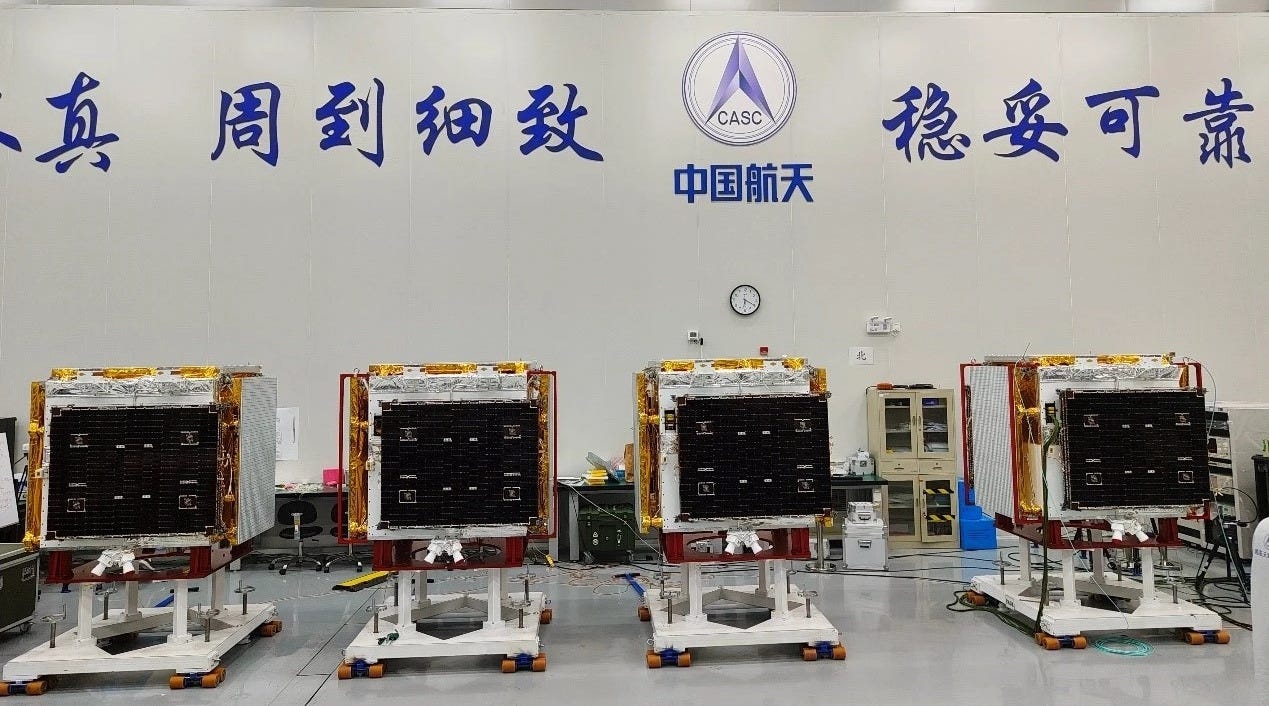Another Commercial Imaging Group [Long March 2C Y55]
Four new X-band synthetic aperture radar imaging satellites are in orbit after a launch from Jiuquan.
A Long March 2C blasted off from Launch Area 4 at the Jiuquan Satellite Launch Center at 11:39 am China Standard Time, or 03:39 am Universal Coordinated Time, on November 9th. This launch had the vehicle flying to a sun-synchronus orbit carrying four satellites.
The four spacecraft atop of the rocket were a group of PIESAT-02 satellites. These satellites were developed by the Shanghai Academy of Spaceflight Technology for X-band synthetic aperture radar imaging. These satellites will be owned and operated by Zhuzhou Space Interstellar Satellite Technology Co Ltd (株洲太空星际卫星科技有限公司), doubling the size of their satellite fleet.
In March 2023 Zhuzhou Space’s first group of PIESAT spacecraft were launched from the Taiyuan Satellite Launch Center, and placed into a sun-synchronous orbit. Back in October of this year, the company announced that it would launch twelve more satellites to build sixteen spacecraft synthetic aperture radar imaging constellation. This constellation, believed to be called “Zhuzhou Constellation”, would allow for regular revisit imaging for most of China once operational, with the company’s technical director Tang Daquan (汤大权) stating:
"After all 16 satellites are launched, the time interval between two consecutive observations of the same location can be greatly shortened. Any location in the country can be revisited within 2.5 hours, thus enhancing the efficiency of imaging monitoring and deformation measurement on a global scale"
If there are any problems with this translation please reach out and correct me.
Based on the plans announced last month, at least two more launches are expected. One of these launches will take place in December and the other before the end of March 2025. Four C-band synthetic aperture radar satellites are also planned to be a part of the constellation. The constellation is currently expected to be fully operational in mid-2025.
To allow the four satellites to be delivered in one mission, the Long March 2C was equipped with its 4.2-meter diameter fairing along with a central load-bearing structure.
This was the 80th launch of the Long March 2C, and was the 544th launch of the Long March launch vehicle series. Along with these, this was also the 53rd launch from China in 2024.
Liftoff video via 北京蓝龙 and 航天五线谱 on Weibo.
As of writing (November 9th), the Y number for this launch is believed to be Y55, this may change if clarified by the manufacturer.
Chinese companies, state-owned and private, use Y followed by a number to serialize launch mission numbering, similar to NASA with STS.
Check out the previous Long March 2C launch
How many eyes? [Long March 2C Y87]
On October 23rd at 09:09 am China Standard Time, or 01:09 Universal Coordinated Time, a Long March 2C lifted off from Launch Complex 3 at the Xichang Satellite Launch Center and headed for low Earth orbit.
What is the Long March 2C?
This section is for those less familiar with China's Long March series of launch vehicles.
The Long March 2C is one of the oldest launch vehicles from China performing missions regularly to low earth and sun-synchronous orbits by the China Academy of Launch Vehicle Technology. The two stages of the launch vehicle both burn Dinitrogen Tetroxide and Unsymmetrical Dimethylhydrazine.
The payload capacity of the launch vehicle is currently as follows:
3,850 kilograms to low Earth orbit
1,900 kilograms to a sun-synchronous orbit
1,250 kilograms to a geostationary transfer orbit
The first-stage is powered by four YF-21C engines, which generate 302 tons of thrust burning Dinitrogen Tetroxide and Unsymmetrical Dimethylhydrazine. The second-stage is powered by a single YF-22E engine and four YF-23C verniers that generate 80 tons of thrust while also burning Dinitrogen Tetroxide and Unsymmetrical Dimethylhydrazine.
On the launch pad, the Long March 2C is 42 meters tall and weighs 233,000 kilograms when fully fuelled. The first and second stages have a diameter of 3.35 meters, with the fairing having a diameter of either 3.35 or 4.2 meters.
So far the Long March 2C has flown from all three inland launch sites, the Jiuquan Satellite Launch Center, the Taiyuan Satellite Launch Center, and the Xichang Satellite Launch Center.






![How many eyes? [Long March 2C Y87]](https://substackcdn.com/image/fetch/$s_!5Pqp!,w_1300,h_650,c_fill,f_auto,q_auto:good,fl_progressive:steep,g_auto/https%3A%2F%2Fsubstack-post-media.s3.amazonaws.com%2Fpublic%2Fimages%2Fbce528fb-7559-41e1-9662-1712602d5276_2000x1063.jpeg)
